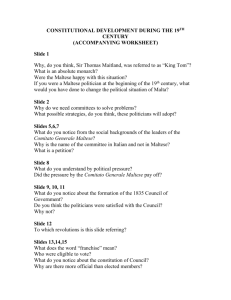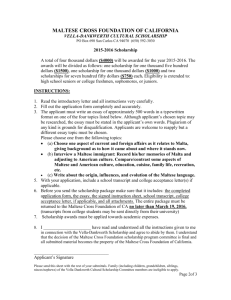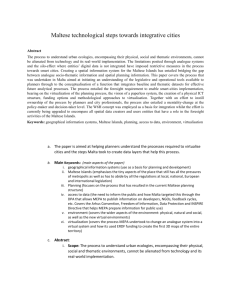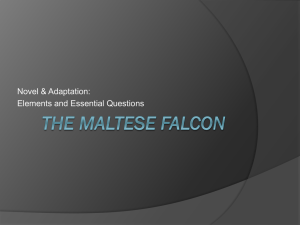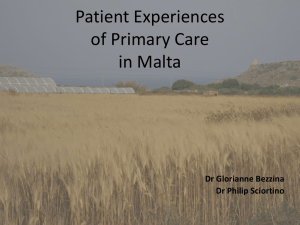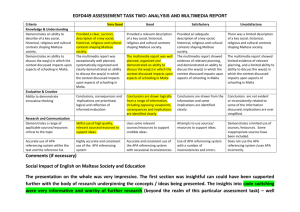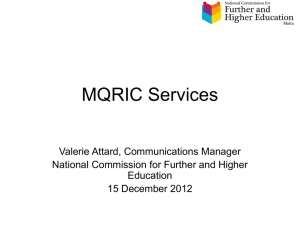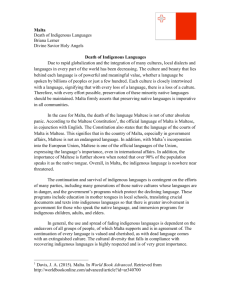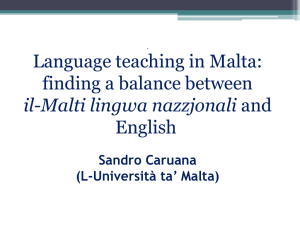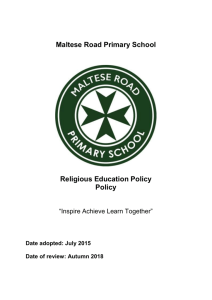Maltese: Brief chapter outline
advertisement
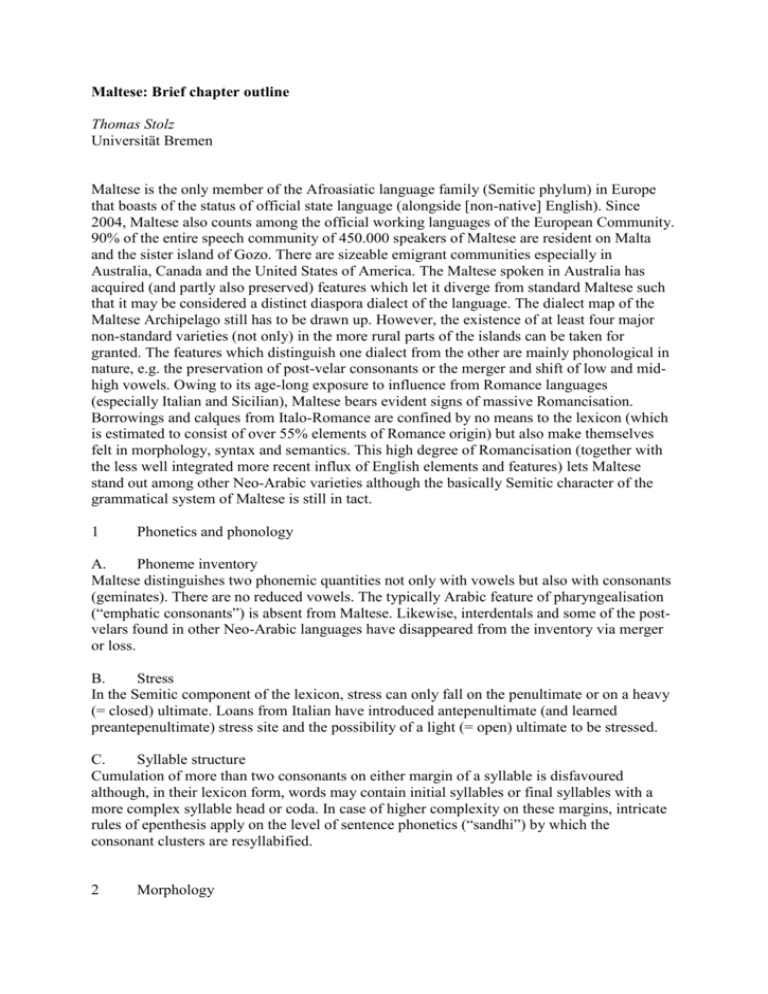
Maltese: Brief chapter outline Thomas Stolz Universität Bremen Maltese is the only member of the Afroasiatic language family (Semitic phylum) in Europe that boasts of the status of official state language (alongside [non-native] English). Since 2004, Maltese also counts among the official working languages of the European Community. 90% of the entire speech community of 450.000 speakers of Maltese are resident on Malta and the sister island of Gozo. There are sizeable emigrant communities especially in Australia, Canada and the United States of America. The Maltese spoken in Australia has acquired (and partly also preserved) features which let it diverge from standard Maltese such that it may be considered a distinct diaspora dialect of the language. The dialect map of the Maltese Archipelago still has to be drawn up. However, the existence of at least four major non-standard varieties (not only) in the more rural parts of the islands can be taken for granted. The features which distinguish one dialect from the other are mainly phonological in nature, e.g. the preservation of post-velar consonants or the merger and shift of low and midhigh vowels. Owing to its age-long exposure to influence from Romance languages (especially Italian and Sicilian), Maltese bears evident signs of massive Romancisation. Borrowings and calques from Italo-Romance are confined by no means to the lexicon (which is estimated to consist of over 55% elements of Romance origin) but also make themselves felt in morphology, syntax and semantics. This high degree of Romancisation (together with the less well integrated more recent influx of English elements and features) lets Maltese stand out among other Neo-Arabic varieties although the basically Semitic character of the grammatical system of Maltese is still in tact. 1 Phonetics and phonology A. Phoneme inventory Maltese distinguishes two phonemic quantities not only with vowels but also with consonants (geminates). There are no reduced vowels. The typically Arabic feature of pharyngealisation (“emphatic consonants”) is absent from Maltese. Likewise, interdentals and some of the postvelars found in other Neo-Arabic languages have disappeared from the inventory via merger or loss. B. Stress In the Semitic component of the lexicon, stress can only fall on the penultimate or on a heavy (= closed) ultimate. Loans from Italian have introduced antepenultimate (and learned preantepenultimate) stress site and the possibility of a light (= open) ultimate to be stressed. C. Syllable structure Cumulation of more than two consonants on either margin of a syllable is disfavoured although, in their lexicon form, words may contain initial syllables or final syllables with a more complex syllable head or coda. In case of higher complexity on these margins, intricate rules of epenthesis apply on the level of sentence phonetics (“sandhi”) by which the consonant clusters are resyllabified. 2 Morphology A. Morphological type Typologically, Maltese is mixed as to the morphological strategies it employs. Mostly in the Semitic part of lexicon and grammar, introflexion (by [multiple] vowel replacement etc.) is very prominent. Prefixation, Infixation and Suffixation are used for a wide variety of grammatical purposes. Internal modification is employed as well. In addition, there are also analytic constructions. Suppletion is only weakly represented in the morphological system. B. Word structure Nouns, adjectives, the numeral one, demonstratives, verbs, pseudo-verbs (or “special adverbs”) and prepositions inflect whereas personal pronouns, definite article, the majority of the numerals, conjunctions and interjections do not inflect. C. Gender, number, case and (in)definiteness inside nominal constituents There are two genders, masculine and feminine, which are distinguished formally in the singular whereas the plural is not sensitive to gender distinctions. The gender opposition does not only hold for nouns but is also relevant for the 3rd person singular subject of verbs as masculine and feminine trigger different affixes. Nouns distinguish singular and plural regularly. For a small set of items, there is also a residual dual number. Quite a few nouns additionally have a collective and a singulative form and thus some nouns have a paradigm of five numbers (to which the so-called “exact” plural may be added as a sixth category). Verbs only distinguish singular and plural. Case is not a morphological category in Maltese. Definiteness is marked by proclitics on the initial word of the NP. Adjectives agree with their head-noun in gender and number (also predicatively). There is also a kind of formal definiteness agreement on adjectives which, however, is used for contrastive focus. Indefiniteness is not overtly marked by phonological material. Inalienable nouns may be possessor-marked by suffixation. D. Mood, tense, aspect and voice (including non-finite verb forms) Maltese has no morphological infinitive. The two participles (active and passive) do not replace the infinitive but function as gerunds and proper passive participles, respectively. Thus, the marking of a number of verbal categories is achieved by chains of formally finite verbs. Maltese is an aspect language. Every Maltese verb has two paradigms: a prefixing paradigm for the imperfective and a suffixing paradigm for the perfective. Proper tense distinctions are only possible via verb-chaining. Only the copula has a distinct inflection for future. With the aid of this future form, irrealis and conditional can be construed. There is no full-blown copula in the present tense. Reflexive-passive and causative are marked by infixation, prefixation and/or consonant germination in the inherited Semitic component of Maltese. In addition, there is a passive periphrasis calqued on an Italian pattern which allows for a personal passive. 3 Syntax and semantics A. Word order type Maltese displays the typical properties of a basically SVO language with a highly flexible, pragmatically determined word order. This flexibility is largely reminiscent of what is known from Italian. Pronouns are only used as topic or focus pronouns, in all other respects, Maltese is a pro-drop language. B. Order inside the nominal phrase Adjectives normally follow their head nouns but may wind up in pronominal position under focus. Except for the numeral one, all cardinal numerals precede the noun they quantify and this is also the order for other quantifiers. Demonstratives are located to the left of the noun which has to host the definite article if the demonstrative is used (proper nouns are exempt from this rule). C. Order inside the verbal phrase The verb chains of Maltese are ordered internally as follows: Aux > TMA > Phasal verb > Modal verb > TMA > Phasal verb > Lexical verb In this chain, non-verbal elements may be inserted mostly in the Wackernagel position to the right of the initial member of a verb chain.
